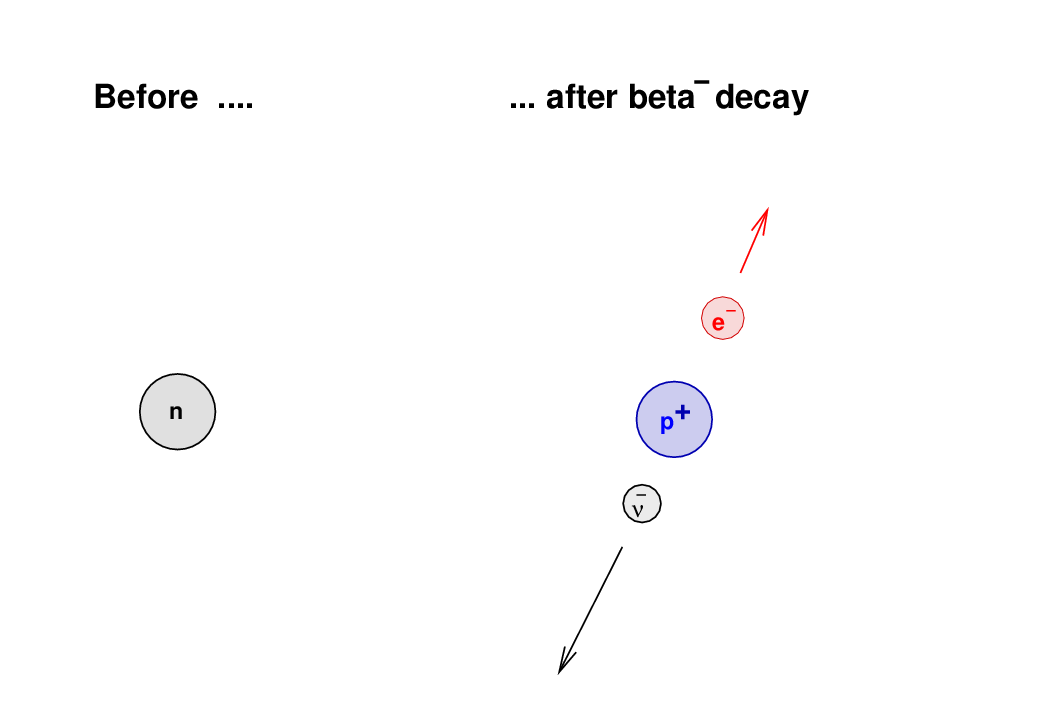
 Copyright © Michael Richmond.
This work is licensed under a Creative Commons License.
Copyright © Michael Richmond.
This work is licensed under a Creative Commons License.
Neutrinos are one variety of the many sub-atomic particles which fill our universe. You may be more familiar with the good ol' trio of ordinary matter -- electrons, protons, and neutrons -- and the photons which are produced in their interactions. Neutrinos are somewhat less commonly encountered, for several reasons that we will discuss. This lecture (and the following one) focus on using neutrinos to observe properties of celestial objects, so it will skip over most of what we know about them. See the references at the end of the lecture for more details, and for links to more comprehensive resources.
Let's start with a very simple interaction: the decay of an isolated neutron. This is also known as beta-minus decay. Note that the particle created here is an electron anti-neutrino.

In another version (beta-plus decay), a proton transmutes into a neutron, positron, and (regular, not anti-) neutrino.
Wondering how you can figure out whether any particular reaction involves regular neutrinos, or anti-neutrinos? A very brief guide
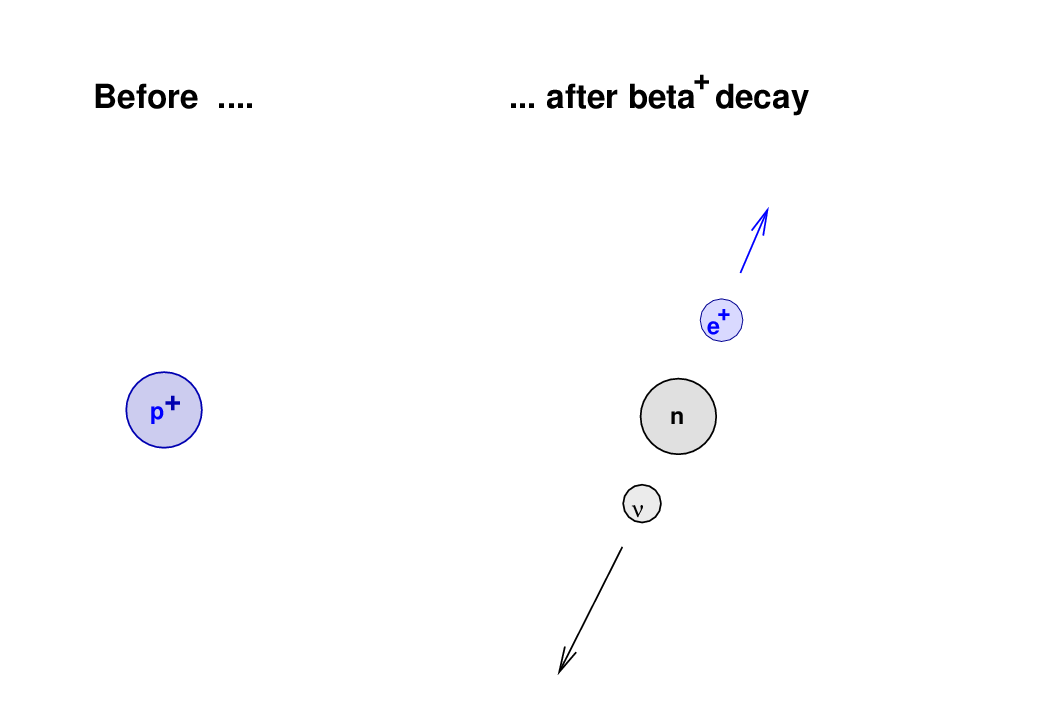
So, which of these two reactions is most likely to be important for astronomical observations? Let's consider one situation in which stars might produce neutrinos.
Q) Deep in the cores of main-sequence stars,
hydrogen fuses into helium.
Which reaction is most common?
Right: both the p-p chain and CNO cycle act to convert 4 hydrogen nuclei (4 protons) into 1 helium nucleus (2 protons + 2 neutrons); the net effect is to turn protons into neutrons, so this must involve beta-plus decays, and produce electron neutrinos.
There are also neutrinos associated with muons and tau mesons, called "muon neutrinos" and "tau neutrinos", respectively. We'll ignore them for the moment, but they will play an important part in the story a bit later.
Cosmic Gall, by John UpdikeNeutrinos they are very small.
They have no charge and have no mass
And do not interact at all.
The earth is just a silly ball
To them, through which they simply pass,
Like dustmaids down a drafty hall
Or photons through a sheet of glass.
They snub the most exquisite gas,
Ignore the most substantial wall,
Cold-shoulder steel and sounding brass,
Insult the stallion in his stall,
And, scorning barriers of class,
Infiltrate you and me! Like tall
And painless guillotines, they fall
Down through our heads into the grass.
At night, they enter at Nepal
And pierce the lover and his lass
From underneath the bed - you call
It wonderful; I call it crass.
Yes, neutrinos really are hard to detect. How hard?
Consider the notion of a "cross-section", which indicates the probability that a particle will interact with some substance as it flies through it. As described in detail in this other lecture, one can define a quantity

associated with a particle and some particular sort of reaction. The larger the cross-section, the more likely the reaction will occur.
We can then use the cross-section to compute the typical distance the particle might travel through a substance before one interaction occurs. For example, if we are interested in interactions between a neutrino and a proton, then we need to compute the number density of protons per cubic meter in the substance, like this:

where ρ is the mass density of the substance (kg/m3), and mp is the mass of a proton (kg).
Well, this is an approximation, since it assumes that the material in question is completely made up of protons. Most materials are a mixture of protons and neutrons, so we'd have to add a correction factor of order unity to account for the slightly smaller number of protons in most materials.
Then the typical distance a neutrino will travel before interacting with a proton will be
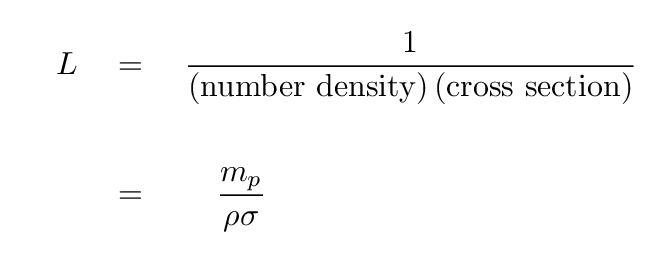
We could write a similar equation for the interaction of a photon with a proton.
The exact values of the cross-section for these interactions are complicated, and depend on the energy of the neutrino (or photon), but for very rough purposes, let's adopt the following values, which might be appropriate for a photon of energy 1 MeV:

Notice the VERY large difference! Interactions between photons and protons are mediated by the electromagnetic force, while those between neutrinos and protons are mediated by the nuclear weak force. Let's see how this difference in cross section translates into a distance each particle can travel through matter. Let's choose water as the medium, since it's cheap and easy to get.
Q: Compute the typical distance a PHOTON (of 1 MeV) might travel
through a big tank of water before interacting
with a proton.
Q: Compute the typical distance a NEUTRINO (of 1 MeV) might travel
through a big tank of water before interacting
with a proton.
Yes, there's a reason why neutrinos are called "elusive."
Clearly, it will be very difficult to detect neutrinos. So why should we bother?
Two very good reasons involve the Sun:
So, if we want to check our theories of solar energy generation -- and, indirectly, stellar energy generation -- neutrinos are really the only direct tracers of these reactions.
Just what are these reactions? That's a rather complicated topic, as there are many different actors, and several pathways through which they interact. A very very simplified view is
4 protons --> 1 He nucleus + 2 positrons + 2 neutrinos + gamma-rays
but the real story is more complex. For our purposes, we can break it down into a first step, and then one of several second steps.
And I'm ignoring contributions from the CNO cycle in the Sun; they are much less common than the p-p chain, so it's not so bad a simplification ...

The neutrinos created in this reaction are low in energy, with E ≤ 0.42 MeV. We need two deuterons (plus other stuff) to create a single Helium, so this step must run twice per complete fusion reaction, creating two low-energy neutrinos.
There's also a second, less-likely reaction, in which a proton (p) and electron (e) and second proton (p) all come together at once, resulting in a deuteron plus a neutrino; this "pep" process creates a somewhat more energetic neutrino, with an energy of E = 1.445 MeV. This reaction produces only about 0.44% of the deuterons, and likewise creates many fewer neutrinos than the main reaction.
The figure below summarizes the type of neutrinos generated within the core of the Sun. The quantity of neutrinos is shown on the vertical axis, and their energy on the horizontal axis. Note that the great, great, great majority of neutrinos have energies less than 1 MeV. Only the uncommon p-e-p reaction, and the VERY rare pp III pathway (labelled as 8B on the graph), produce neutrinos with higher energies.
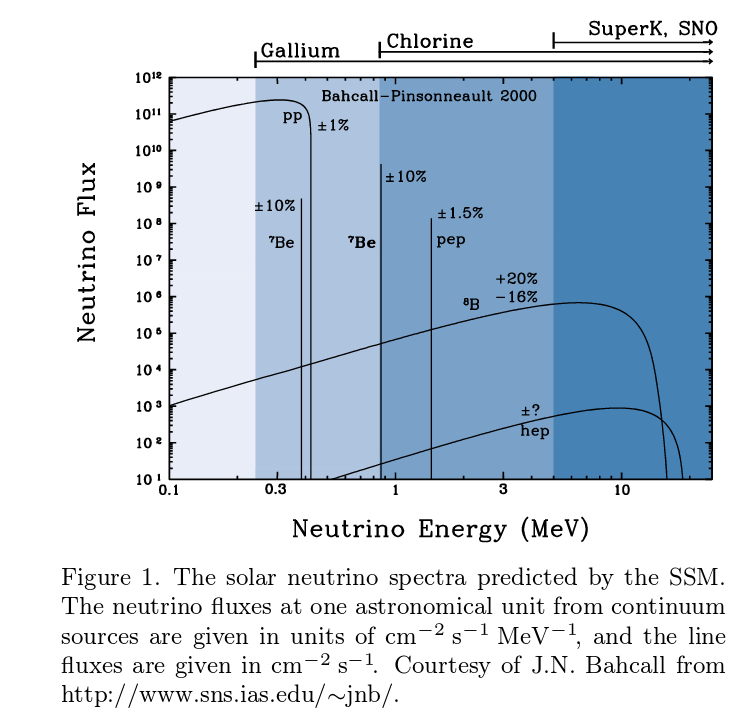
Figure 1 taken from
Review of Solar Neutrino Experiments
by A. Bellerive (2003)
So, if we want to study the reactions which occur in the core of the Sun, we ought to use a neutrino telescope which can detect low-energy neutrinos.
Unfortunately, the first real neutrino telescope was completely UNABLE to detect low-energy neutrinos. Arrghh.
Physicist Ray Davis was the driving force behind the first real neutrino telescope, a giant tank of cleaning fluid placed almost 5000 feet below the surface of the Earth in the Homestake mine of South Dakota.
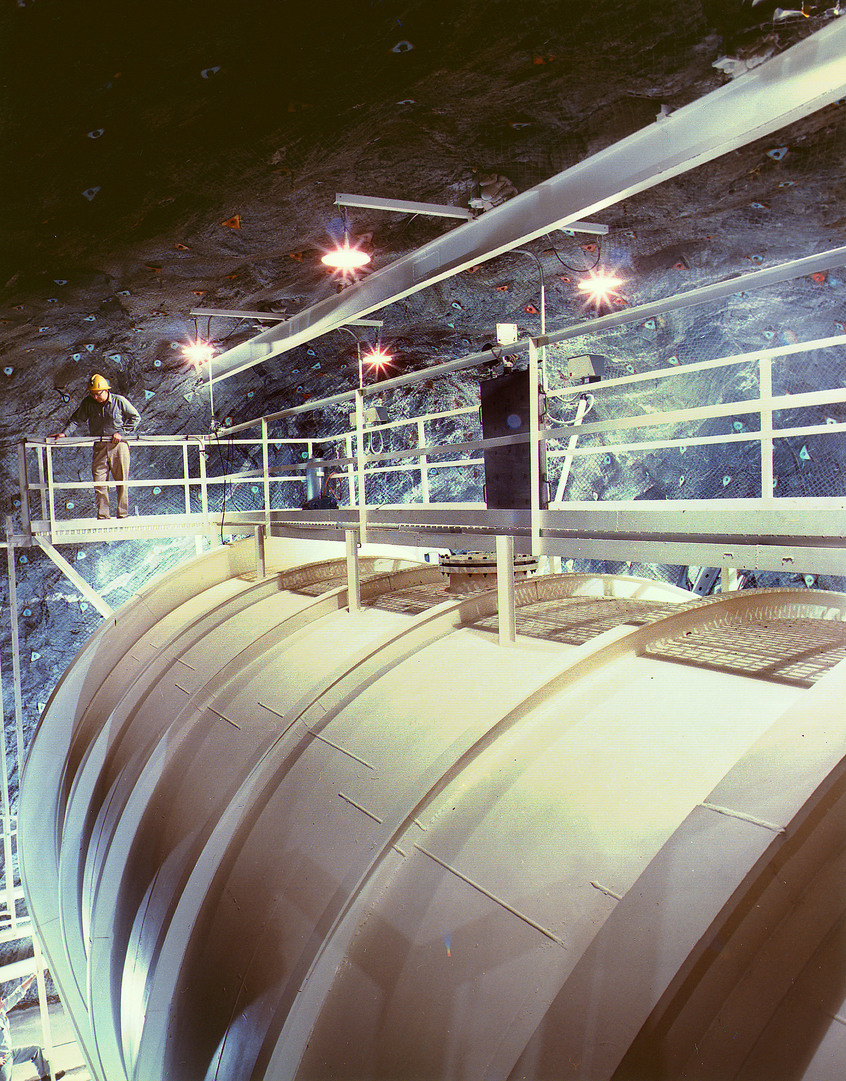
Image of Homestake mine tank courtesy of
Brookhaven National Lab
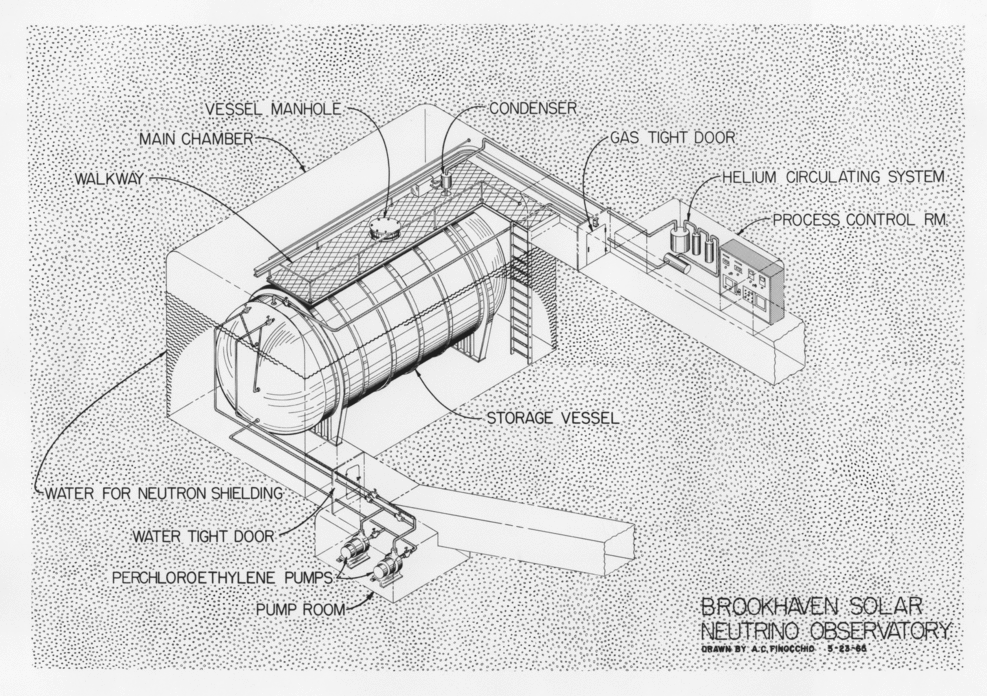
Schematic of Homestake mine tank courtesy of
Brookhaven National Lab
Q: Why go to the trouble of building this giant tank
deep under the surface of the Earth?
The tank was filled with perchlorethylene, a chemical used for dry cleaning, which happens to be mostly chlorine: C2Cl4. Chlorine, with 17 protons, has several different isotopes. The most common are 35Cl, accounting for about 75% of all atoms, and 37Cl, accounting for about 25% of them.
It's the heavier variety which is of interest for neutrino hunters. If a neutrino with an energy of ≥ 0.9 MeV should happen to bump into one of the neutrons in such an atom, it might convert it into a proton, turning the chlorine into 37Ar. (This is an example of "neutrino-induced inverse beta decay").

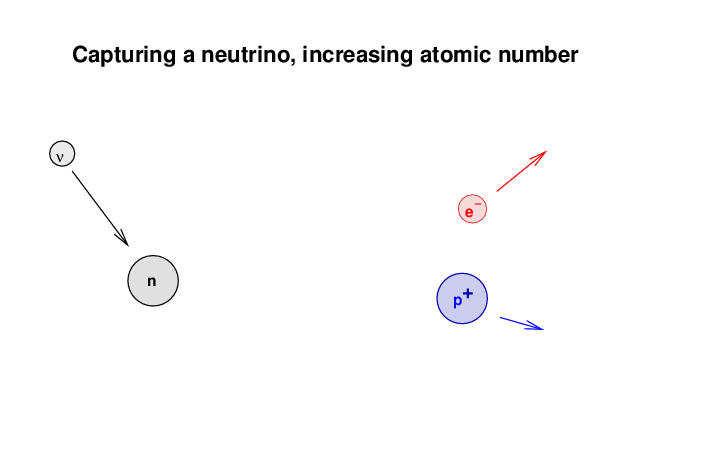
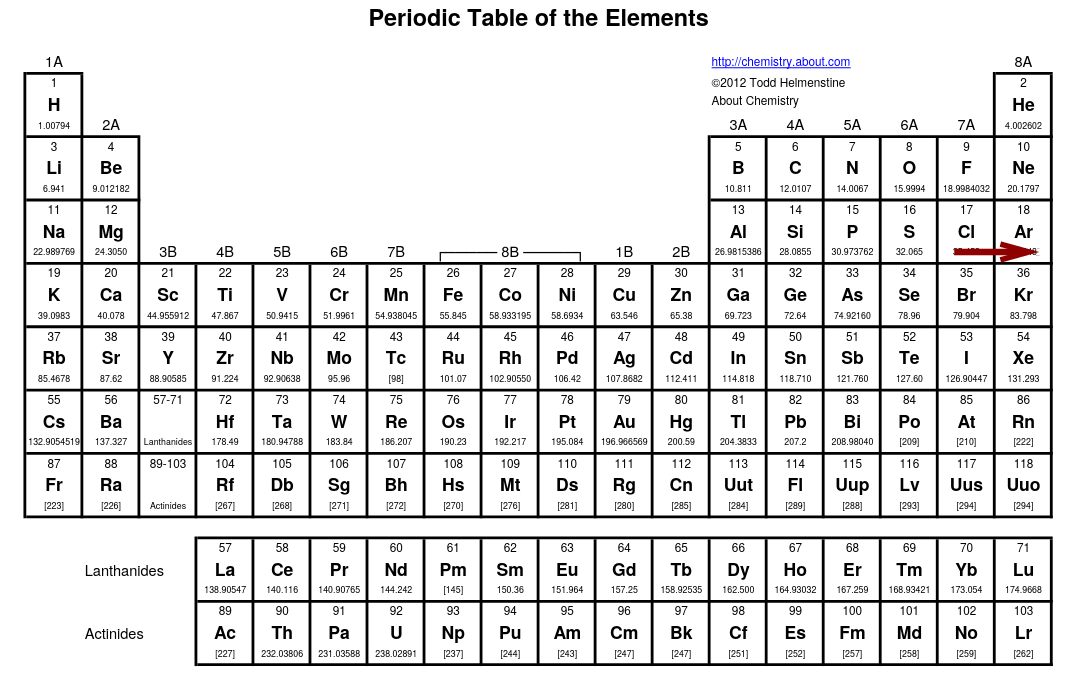
Now, this isotope of argon is not stable, decaying back into chlorine with a half-life of about 34 days. When it decays, the argon emits a gamma-ray with an energy of 0.82 MeV -- and that gamma-ray is the signal that a neutrino was intercepted by the big tank of fluid. Since the number of interactions is very small, maybe one or two per day, the experimental procedures are pretty crazy, both to find every precious argon atom in that giant volume, and to account for any spurious readings due to background radiation.
Q: Does this neutrino telescope provide a measurement
of the incoming neutrino's direction?
No, alas, it does not. We know that a neutrino passed through the detector, but we have no idea which way it was going. This sort of "chemical-based" detector does not preserve directions. If you wish, you can argue that the Homestake experiment wasn't detecting solar neutrinos at all (but later evidence from other sources indicates that it was, so don't bother).
As years passed, the statistics generated by the experiment became more reliable, but they weren't converging on the expected values. The number of neutrinos detected was only about one third of the expected number. This deficit became known as the "solar neutrino problem."
Where was the problem?
Note that the first possibility was a real worry. In order to convert a chlorine atom into an argon atom, an incoming neutrino must have an energy of at least 0.9 MeV -- and that means that the Homestake experiment was IGNORING something like 99.99% of all the neutrinos produced by a variety of reactions inside the Sun. It was only detecting the teeny-tiny fraction of those representing one particular, uncommon, pathway. If the calculations by nuclear physicists of the rates of these uncommon reactions were even a tiny bit incorrect, it might explain this deficit.
What we really needed was a way to detect at least some of the neutrinos produced in the common fusion reactions. All of these neutrinos have energies of less than 0.5 MeV.

Figure 1 taken from
Review of Solar Neutrino Experiments
by A. Bellerive (2003)
In the late 1980s and early 1990s, two new neutrino telescopes went into action, specially designed to find these common, low-energy neutrinos.
Both used a different element: Gallium. The reaction in this case involves the transmutation of gallium (Ga) to germanium (Ge), like so:

Note that this reaction is another example of of "neutrino-induced inverse beta decay", in which a neutrino interacts with a neutron, producing an proton (and hence an element which is one spot further along the periodic table) and an electron.
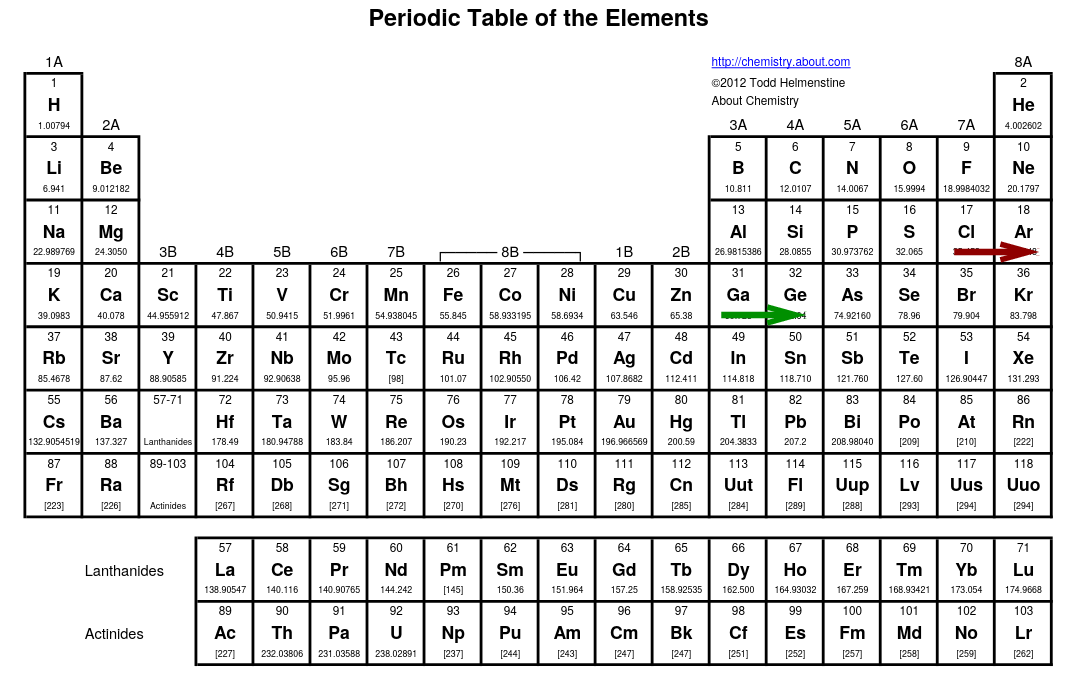
The important difference is that the threshold for this reaction is much lower, so that neutrinos with energies as low as 0.233 MeV can trigger it. That means that the new experiments could at last detect directly the neutrinos produced in the most common of the solar fusion reactions, the combination of two protons to create a deuteron.

Figure 1 taken from
Review of Solar Neutrino Experiments
by A. Bellerive (2003)
The gallium-based experiments are in some ways similar to the Homestake detector: they feature large vats full of liquid (in the case of SAGE, liquid gallium, which has a low melting point), inside which a neutrino triggers the creation of a radioactive isotope of a new element. In this case, 71Ge has a half-life of about 11.4 days, after which it decays back to gallium, emitting characteristic X-rays with specific energies (around 10.4 and 1.2 keV). Detecting those X-rays is the signal that a neutrino has interacted with the tank.
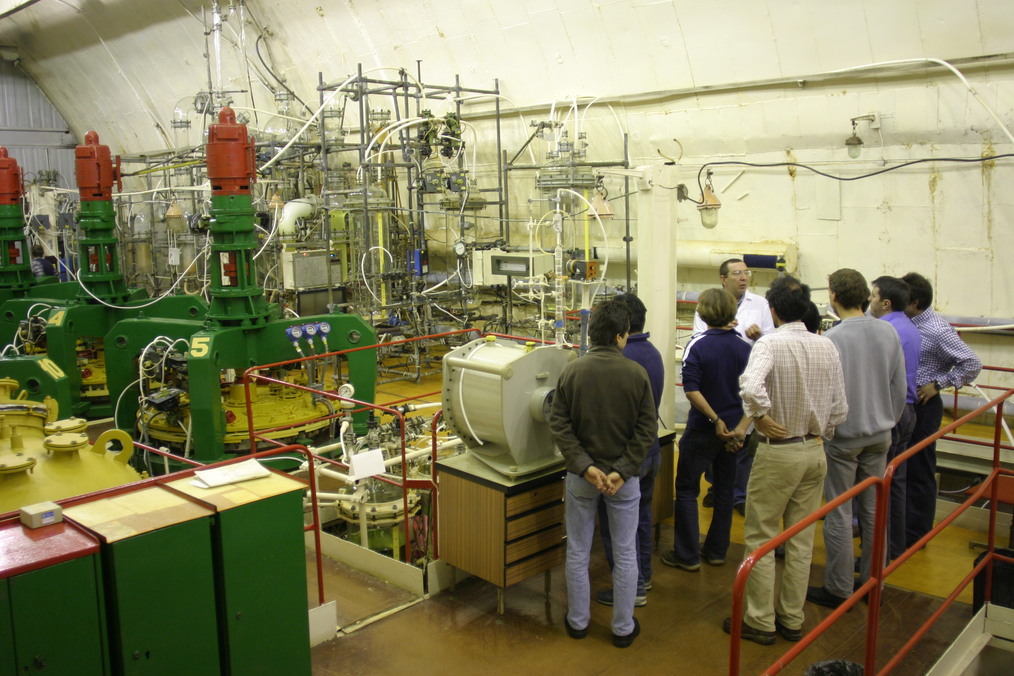
Image of SAGE experiment courtesy of
Baksan School of Russia
Let's take a moment to estimate the number of neutrinos which ought to interact with one of these gallium-based telescopes. Our value will be very approximate, but give you an idea for the order of magnitude.
3
SAGE contains about M = 50 x 10 kg of gallium
a) how many atoms of Ga-71?
b) how many neutrons?
-50
The cross section of one neutron to a neutrino is roughly 10 sq. m.
c) what is the cross section of all the neutrons in the detector
combined?
26
The solar luminosity is L = 3.8 x 10 Joules per second.
-12
Each fusion releases a total of roughly Ef = 4.3 x 10 Joules
and 2 low-energy neutrinos.
d) how many low-energy neutrinos are produced in the Sun per second?
e) what is the flux of neutrinos per sq. m. at the Earth?
And finally, the big question,
f) what is the rate of neutrino interactions with the detector?
The actual number detected by SAGE was very roughly 0.5 per day; that's a bit lower than our calculation, which omits lots of details.
The solution to the solar neutrino problem
With the gallium detectors, physicists could at least remove from their list of uncertainties the fact that they weren't including the most common reactions. But both the SAGE and GALLEX experiments measured a number of neutrinos which was SMALLER than the number expected from theory. The solar neutrino problem did not disappear.
Q: What is the solution to the solar neutrino problem?
It turns out that neutrinos are closely related to the subatomic particles called leptons. There are three flavors of leptons:
The lepton of most interest to astronomers is the electron, of course, because most celestial objects consist of ordinary matter: electrons, protons, neutrons.
Each flavor of lepton has its own associated neutrino. The neutrino we've been discussing so far, produced in reactions involving electrons, is called the "electron neutrino", or νe for short. But reactions involving muons will create "muon neutrinos", and those involving taus will create "tau neutrinos".

As physicists pondered the missing solar neutrinos during the 1980s and 1990s, they considered a theoretical possibility: neutrino oscillations. This idea, introduced in the 1950s and 1960s by Bruno Pontecorvo, postulated that neutrinos of one flavor might change into neutrinos of a different flavor. All the neutrinos produced in solar fusion should be the electron variety, but what if some of them turned into muon or tau neutrinos as they were flying to the Earth? The trip takes a bit over 8 minutes, and ends with a short path through the Earth's atmosphere. Could that give the electron neutrinos enough time to turn into neutrinos of other flavors -- which the "chemical-based" neutrino telescopes would not detect?
The answer was "yes."
You have calculated the rate at which solar neutrinos interact with several "chemical-based" neutrino detectors. The Sun, of course, is the closest star, but we believe that all (ordinary) stars are producing neutrinos in their cores.
Q: Can we see other stars in these neutrino telescopes?
Why or why not? Justify your answer.
 Copyright © Michael Richmond.
This work is licensed under a Creative Commons License.
Copyright © Michael Richmond.
This work is licensed under a Creative Commons License.